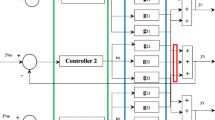Abstract
The goal of this paper is to identify and control multi-input multi-output (MIMO) processes by means of the dynamic partial least squares (PLS) model, which consists of a memoryless PLS model connected in series with linear dynamic models. Unlike the traditional decoupling MIMO process, the dynamic PLS model can decompose the MIMO process into a multiloop control system in a reduced subspace. Without the decoupler design, the optimal tuning multiloop PID controller based on the concept of general minimum variance and the constrained criteria can be directly and separately applied to each control loop under the proposed PLS modeling structure. Several potential applications using this technique are demonstrated.
Similar content being viewed by others
References
Banyasz, C. and Keviczky, L., “Design of Adaptive PID Regulators Based on Recursive Estimation of the Process Parameters,”J. of Proc. Cont.,3, 53 (1993).
Bohim Bobal, V. J. and Prokop, R., “Practice Aspects of Self-tuning Controllers,”International Journal of Adaptive Control and Signal Processing,13, 671 (1999).
Cameron, F. and Seborg, D. E., “A Self-Tuning Controller with a PID Structure,”Int. Journal of Control,30, 401 (1983).
Gawthrop, P. J., “Self-Tuning PID Controllers: Algorithm and Implementation,”IEEE Trans. on Automatic Control,31, 201 (1986).
Garcia, C. E. and Morari, M., “Internal Model Control 1. A Unifying Review and Some New Results,”Ind. Eng. Chem. Process Des. Dev.,21, 308 (1982).
Chen, J. and Yen, J.-H., “Three-Way Data Analysis with Time Lagged Window for On-Line Batch Process Monitoring,”Korean J. Chem. Eng.,20, 1000 (2003).
Chen, J. and Yea, Y., “Neural Network-Based Predictive Control for Multivariable Processes,”Chem. Eng. Comm.,189, 865 (2002).
Eastment, H. T. and Krzanowski, W., “Cross-Validatory Choice of the Number of Components from a Principal Component Analysis,”Technometrics,24, 73 (1982).
Han, I.-S., Kim, M., Lee, C.-H., Cha, W., Ham, B.-K., Jeong, J.H., Lee, H., Chung, C.-B. and Han, C., “Application of Partial Least Squares Methods to a Terephthalic Acid Manufacturing Process for Product Quality Control,”Korean J. Chem. Eng.,20, 977 (2003).
Höskuldsson, A., “PLS Regression Methods,”J. of Chemometrics,2, 211 (1988).
Kashiwagi, H. and Li, Y., “Nonparametric Nonlinear Model Predictive Control,”Korean J. Chem. Eng.,21, 329 (2004).
Kaspar, M. H. and Ray, W. H., “Chemometric Methods for Process Monitoring and High Performance Controller Design,”AIChE J.,38, 1539 (1992).
Kaspar, M.H. and Ray, W.H., “Dynamic PLS Modelling for Process Control,”Chem. Eng. Sci.,48, 3447 (1993).
Kourti, T. and MacGregor, J. F., “Multivariate SPC Methods for Process and Product Monitoring,”J. Quality Technology,28, 409 (1996).
Ku, W., Storer, R.H. and Georgakis, C., “Disturbance Detection and Isolation by Dynamic Principal Component Analysis,”Chemom. Intell. Lab. Syst.,30, 179 (1995).
Lakshminaraynan, S., Shan, S. L. and Nandakumar, K., “Modeling and Control of Multivariable Processes: Dynamic PLS Approach,”AIChE J.,43, 2307(1997).
Luyben, W. L., “Simple Method for Tuning SISO Controllers in Multivariable Systems,”Industrial and Engineering Chemistry,25, 654 (1986).
Nahas, E. P., Henson, M.A. and Seborg, D. E., “Nonlinear Internal Model Control Strategy for Neural Network Models,”Computer and Chemical Engineering,12, 1039 (1992).
Ortega, R. and Kelly, R., “PID Self-Tuners: Some Theoretical and Practice Aspects,”IEEE Trans. on Industrial Electronics,31, 312 (1984).
Oh, S.C. and Yeo, Y.-K., “A Study on the Adaptive Predictive Control Method for Multivariable Bilinear Processes,”Korean J. Chem. Eng.,12, 472 (1995).
Palmor, Z. J., Halevi, Y. and Karsney, N., “Automatic Tuning of Decentralized PID Controller for TITO Processes,”Automatica,31, 1001 (1995).
Proudfoot, C.G., Gawthrop, P. J. and Jacobs, O. L. R., “Self-Tuning PI Control of a pH Neutralization Process,”Proc. of IEE, Pt-D,130, 267 (1983).
Qin, S. J. and McAvoy, T. J.,A Data-Based Process Modeling Approach and Its Applications, in Proceedings of the 3rd IFAC Symposium on Dynamic and Control of Chemical Reactors, Distillation Columns, and Batch Process, Pergamon, Oxford (1992).
Radke, F. and Isermann, R., “A Parameter-Adaptive PID Controller with Stepwise Parameter Optimization,”Automatica,23, 449 (1987).
Reeves, D. E. and Arkun, Y., “Interaction Measures for Nonsquare Decentralized Control Structures,”AIChE J.,35, 603 (1989).
Shiu, S. L. and Huang, S. H., “Sequential Design Method for Multivariable Decoupling and Multiloop PID Controllers,”Ind. Eng. Chem. Res.,37, 107 (1998).
Wittenmark, B.,Self-Tuning PID Controllers Based on Pole Placement, Lund Inst. of Technical Report, TFRT-7179 (1979).
Wolovich, W. A. and Flab, P. L., “On the Structure of Multivariable Systems,”SIAM J. Control,7, 437 (1969).
Zhuang, M. and Atherton, D. P., “PID Controller Design for a TITO System,”IEE Proc. on Control and Applications,141, 111 (1994).
Zwick, W. R. and Velicer, W. F., “Comparison of Five Rules for Determining the Number of Components to Retain,”Psychol. Bull.,99, 432 (1986).
Author information
Authors and Affiliations
Rights and permissions
About this article
Cite this article
Chen, J., Cheng, YC. & Yea, Y. Multiloop PID controller design using partial least squares decoupling structure. Korean J. Chem. Eng. 22, 173–183 (2005). https://doi.org/10.1007/BF02701481
Received:
Accepted:
Issue Date:
DOI: https://doi.org/10.1007/BF02701481




